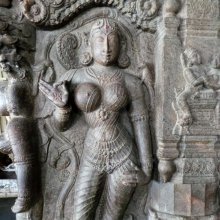Hamsasya, Haṃsāsya, Hamsa-asya: 5 definitions
Introduction:
Hamsasya means something in Hinduism, Sanskrit. If you want to know the exact meaning, history, etymology or English translation of this term then check out the descriptions on this page. Add your comment or reference to a book if you want to contribute to this summary article.
Images (photo gallery)
In Hinduism
Natyashastra (theatrics and dramaturgy)
Source: Wisdom Library: Nāṭya-śāstra1) Haṃsāsya (हंसास्य, “swan-beak”) refers to a gesture (āṅgika) made with a ‘single hand’ (asaṃyuta), according to the Nāṭyaśāstra chapter 8. The hands (hasta) form a part of the human body which represents one of the six major limbs (aṅga) used in dramatic performance. With these limbs are made the various gestures (āṅgika), which form a part of the histrionic representation (abhinaya).
(Instructions of Haṃsāsya): The forefinger, middle finger and the thumb close to one another and the remaining fingers stretched. (Uses of Haṃsāsya): It with the slightly throbbing end is used specially to indicate fine, small, loose, lightness, exit, and softness.
2) Haṃsāsya (हंसास्य, “swan-beak”) is the name of a meter belonging to the Natkuṭa class described in the Nāṭyaśāstra chapter 32.
(longer recension):—“the metre which has in its feet of twelve syllables, the second, the fourth, the sixth, the tenth and the last long, is haṃsāsya”.
(shorter recension):—“the metre which has in its feet of twelve syllables the third, the fourth, the sixth, the seventh, the tenth and the last long, is haṃsāsya”.
Source: archive.org: The mirror of gesture (abhinaya-darpana)One of the Twenty-eight Single Hands (hasta):—Haṃsāsya (swan-face): the middle and following fingers are separated and extended, the forefinger and thumb are joined. Usage: tying the marriage thread, initiation, certainty, horripilation,painting (citra-samlekhana) , gad-fly, drop of water,raising the wick of a lamp, rubbing (metal on a touchstone),examining things, drawing lines, carrying garlands, signifying “Soham” (That am I), metaphor (rūpaka), saying “No!”, indicating things to be examined by rubbing, accomplishment of a task.
According to another book: the tips of the forefinger, middlefinger and thumb are joined, the rest extended. This hand is derived from Dakṣiṇa-mūrti (Śiva), when he was teaching the Tattva system to the sages at the foot of the Nyagrodha tree. Its sage is Śukha, its colour white, its race mixed, its presiding deity Caturānana (Brahmā). Usage: instructing in wisdom, ritual (pūjā), demonstration of a thesis (nirṇaya), offering sesamum, speaking, reading, singing, meditation (dhyāna), demonstrating bhāva, applying wax, horripilation, pearl, gem, sound of the flute, gathering together (samyutta), smell, own self, dropof water, taking aim, seal-ring, kissing, Brāhmaṇa caste, whitecolour.
Source: Shodhganga: Elements of Art and Architecture in the Trtiyakhanda of the Visnudharmottarapurana (natya)Haṃsāsya (हंसास्य) is another name for Haṃsavaktra: one of the twenty-two Asaṃyuktahastas or “single hand gestures” (in Indian Dramas), according to the Viṣṇudharmottarapurāṇa, an ancient Sanskrit text which (being encyclopedic in nature) deals with a variety of cultural topics such as arts, architecture, music, grammar and astronomy.—The hasta-mudrās (lit. “hand-gestures”) are very essential to denote some particular action or state in dancing and these mudrās are formed with the help of hands and fingers.

Natyashastra (नाट्यशास्त्र, nāṭyaśāstra) refers to both the ancient Indian tradition (shastra) of performing arts, (natya—theatrics, drama, dance, music), as well as the name of a Sanskrit work dealing with these subjects. It also teaches the rules for composing Dramatic plays (nataka), construction and performance of Theater, and Poetic works (kavya).
Languages of India and abroad
Sanskrit dictionary
Source: Cologne Digital Sanskrit Dictionaries: Monier-Williams Sanskrit-English DictionaryHaṃsāsya (हंसास्य):—[from haṃsa] m. a [particular] position of the hand, [Catalogue(s)]
[Sanskrit to German]
Sanskrit, also spelled संस्कृतम् (saṃskṛtam), is an ancient language of India commonly seen as the grandmother of the Indo-European language family (even English!). Closely allied with Prakrit and Pali, Sanskrit is more exhaustive in both grammar and terms and has the most extensive collection of literature in the world, greatly surpassing its sister-languages Greek and Latin.
See also (Relevant definitions)
Starts with: Hamsasyahasta.
Full-text: Hamsa, Tungabhadra, Brahma, Vaishya, Bhartri, Shvashru, Asamyuta, Manonmani, Parthasarathi, Bhramara, Hasta, Mukula, Saṃdaṃśa, Hamsavaktra, Lakshminarayana, Sarasvati.
Relevant text
Search found 4 books and stories containing Hamsasya, Haṃsāsya, Hamsa-asya, Haṃsa-āsya; (plurals include: Hamsasyas, Haṃsāsyas, asyas, āsyas). You can also click to the full overview containing English textual excerpts. Below are direct links for the most relevant articles:
Abhinaya-darpana (English) (by Ananda Coomaraswamy)
Plate VII - Hands of Images < [Plates]
Chapter 20 - Hands denoting the Four Castes
Gati in Theory and Practice (by Dr. Sujatha Mohan)
Description of Gati in Abhinayadarpaṇa < [Chapter 2 - Concept and technique of Gati]
Literary and dramatic elements in Nāṭyaśāstra < [Chapter 1 - Nāṭya]
Natyashastra (English) (by Bharata-muni)
Dance Traditions of South India < [January-February 1935]
